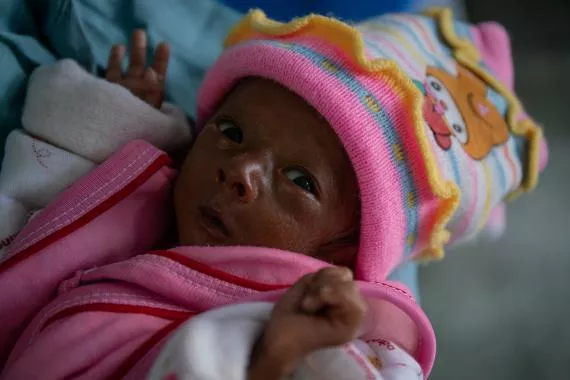Love's embrace
Born prematurely, a little boy in farwestern Nepal has received a new lease on life thanks to Kangaroo Mother Care practices

Dhangadhi, Nepal – On a chilly winter morning in 2018, in their home in Dhangadhi, Sabina Chaudhary held her baby close as her husband Upendra reached around her with a cloth wrapper, binding mother and child together. Little Devansh, just over two months old at the time, nestled into Sabina’s bare chest, his breathing slow and steady.
This particular way of carrying the baby while maintaining skin-to-skin contact was one of the methods Sabina and Upendra learned at the hospital where they had sought help for Devansh, who was born two months prematurely. The practice is a key element of Kangaroo Mother Care (KMC) or Maya ko Angalo (“a loving embrace”) in Nepali, a non-medical intervention aimed at saving the lives of preterm and underweight babies.
The couple had gone to the Seti Zonal Hospital in Dhangadhi, the district headquarters, for a check-up after Sabina started having severe stomach pains. She was seven months pregnant at the time. An ultrasound revealed that she would be giving birth soon.
Two days later, at a clinic close to her home, Devansh came into the world.

It became quickly apparent that the child would need special care. Weighing just around 1,100 grams to begin with, he shortly dropped even lower to 800 grams.
“He was so small,” Sabina says, recalling the first time they saw the baby. “I was crying and thinking, ‘Will he even survive?’…. I was so worried.”
On the advice of the staff at the clinic, Devansh was brought to the Seti Zonal Hospital. Once there, he was immediately put in intensive care.
The next few weeks were hectic, with the couple rushing back and forth between their home and the hospital to get the child the treatment he needed, including for a sudden onset of hepatitis. It was during one of these visits that a nurse at the facility told Sabina and Upendra about KMC.

“She showed us how to hold him close to the skin and secure him in that position,” Sabina says. “If we did it regularly, she said it would keep him warm and help him grow.”
Eager at this point to try anything they could to boost their baby’s fragile health, the new parents were diligent in practicing what they had learned over the next few weeks. Although it was Sabina who more frequently did the carrying, Upendra was always on standby, ready to take over when his wife got too tired or hot and needed to take a break.
Preterm babies are at high risk of physical and mental health complications – even death – if not provided the right care. According to a study in The Lancet, in Nepal, there are 81,900 low birth weight (LBW) babies born annually, with approximately 10,400 infant deaths due to complications related to LBW. The KMC method has proved an effective response in this context, enabling parents to use their own bodies to create an incubator-like environment where babies are protected from the cold. The technique is also said to help build emotional bonds between the parent and infant in these crucial early moments.
Upendra notes that this was one of the reasons he was so keen to share childcare responsibilities with his wife.
“I wanted him to feel just as safe and comfortable with me as he did with his mother, because he’s my baby too,” he says. “The KMC sessions helped a lot in creating that bond between us.”


“I don’t see why all the work should fall on women, in any case. I might not be able to breastfeed, but there’s so much more I can do to help,” he adds.
Much to the couple’s relief, they soon started to see small changes in Devansh’s health. He was getting more active and slowly gaining weight. “The more we did it, the more encouraged we were by the results to keep going,” Sabina says.
Apart from skin-to-skin contact, health workers and nurses at the hospital also offered the couple constant feedback and guidance related to feeding, another important aspect of KMC. Since it was difficult to breastfeed Devansh for a few days in the beginning, they were taught to use a ‘nifty cup’, a small cup-shaped device designed to help infants take in expressed mother’s milk more easily.

Such efforts to instruct parents like Sabina and Upendra on the methods and advantages of KMC are among a number of services that have been initiated at the Seti Zonal Hospital’s Neonatal Intensive Care Unit (NICU) with UNICEF support. Apart from KMC, UNICEF has helped build the capacity of health staff – including medical doctors, nurses and paramedics – in Level II newborn care, referring to specialty services for preterm and ill newborn babies, and Helping Babies Breathe, a resuscitation programme.
The hospital has also started the Nepal Perinatal Quality Improvement Programme, aimed at enhancing the quality of newborn care through need assessment, orientation/training, Plan-Do-Study-Act (PDSA) cycle, self-assessments and peer review.
All the support provided by the hospital means that today, Devansh is a healthy, lively baby and the apple of his parents’ eyes.
Sabina says they are glad to be beyond those early, fretful days of wondering whether he would make it. “He moves a lot more, and sleeps all day and wakes up all night,” she says.

“Just seeing him open his eyes and look around makes us very happy. We are more confident that he will survive.”





